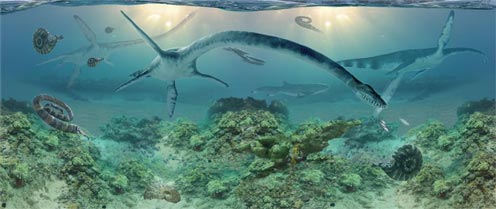New Study Describes Biggest Elasmosaur Known to Science
Giant Elasmosaurs from Antarctica
An scientific paper published in the academic journal “Cretaceous Research” details the remarkable discovery of a huge elasmosaurid plesiosaur from Upper Cretaceous deposits located on Seymour Island in Antarctica. The specimen, ascribed to the Aristonectes genus is estimated to have measured around 11 metres in length and could have weighed as much as fifteen tonnes. The strata from which the fossil material was collected is believed to have been laid down towards the end of the Cretaceous, thus this fossil discovery indicates that very large elasmosaurs were around towards the very end of the Mesozoic.
A Life Reconstruction of a Typical Elasmosaurid Marine Reptile

The image (above) shows an elasmosaur model from the Safari Ltd range.
To view this range of prehistoric animal figures: Safari Ltd. Wild Safari Prehistoric World.
Seymour Island – Helping to Map Marine Fauna at the Very End of the Cretaceous
The exposed sediments on the inhospitable and remote Seymour Island provide palaeontologists with the opportunity to study life that existed at the very end of the age of dinosaurs and the sequence of exposed rocks covers the transition from the end Cretaceous extinction event into the Palaeogene. The occurrence of this specimen, located approximately 2.3 metres or less below the Cretaceous-Palaeogene (K/Pg) boundary, suggests the persistence of these types of plesiosaurs (aristonectines), at high latitudes and also it verifies their chronostratigraphical distribution until the end Cretaceous, before the mass extinction the resulted in the loss of all marine reptiles with the exception of marine turtles.
This is not the first giant, marine reptile to be found on Seymour Island…
To read an article from 2016 which describes the discovery of the remains of a giant mosasaur marine reptile in Maastrichtian-aged deposits on Seymour Island: An Apex Marine Predator from the Late Cretaceous of Antarctica.
The fossil material (MLP 89-III-3-1), consisting of disarticulated post-cranial elements most probably representing an individual animal, comes from the uppermost Maastrichtian levels of the López de Bertodano Formation, Seymour Island (sometimes referred to as Marambio Island), Antarctica. The research team members conclude that this specimen is amongst the largest elasmosaurids known.
A field team found the first evidence of this animal back in 1989, but at the time, the team lacked the resources to excavate the specimen. Subsequent expeditions to the fossil site in 2005, 2012 and 2017 led to the removal of some 800 kilograms of fossil bones.
Large Elasmosaurids Thrived in High Latitudes at the End of the Cretaceous

Picture credit: James Havens
A “Weird Plesiosaur”
Co-author of the scientific paper, José O’Gorman of the National Scientific and Technical Research Council of Argentina, commented that for years the researchers were not sure whether the fossils represented an elasmosaurid or something else, the animal is described as a “weird plesiosaur.”
The large size of this specimen coupled with the giant mosasaur fossils known from this locality suggest that these waters were highly productive and able to support a variety of megafauna. These conditions are likely to have persisted until the K/Pg mass extinction. Although, the animal has not been given a formal, binomial scientific name, the researchers conclude that it has affinities with the Aristonectinae, a sub-family within the Elasmosauridae.
The scientific paper: “A giant elasmosaurid (Sauropterygia; Plesiosauria) from Antarctica: New information on elasmosaurid body size diversity and aristonectine evolutionary scenarios” by
J.P. O’Gorman, S. Santillana, R. Otero and M. Reguero published in the journal Cretaceous Research.
The Everything Dinosaur website: The Website of Everything Dinosaur.

